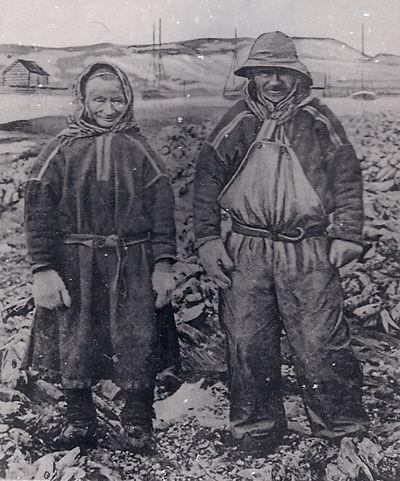The winter dwelling place was most commonly in a fiord bottom, and served as a base for hunting, trapping and freshwater fishing. The forest gave materials for boats, tools and huts, and fodder for the livestock was collected. In summer, people moved closer to the open ocean, and engaged in more specialized fishing and hunting of sea mammals and -birds. The sea Sami early made contact with both Norwegian and Russian buyers of fish. Their economy was thus influenced by imported goods. The opportunities of stable sales, and later also paid work, weakened the old moving patterns, and marginal resources were no longer exploited.
A general history of the sami
The oldest written source that mentions the Sami people dates as far back as 98 A.D. In this source, the Roman historian writes about a people he calls «Fenni». In the year 550 A.D., the Greek Prokopius writes about Thule, the land that lies farthest to the North. Further, he writes about a people that lives in Thule that wears skis. He called them «Skrid-Finns». In 551 A.D., the Goth Jordanes writes about the peoples «Screrefennae» and «Adogit» that lives on the northermost parts of the island «Scandza», where the sin shines for forty days during mid-summer and is gone for an equal amount of days during winter. However, all of these three wrote things they had heard from others.
The chieftain Ottar from Hålogaland, in about 890 A.D., tells the king of England, Alfred the Great, about the Sami people based on his own experiences. A large amount of Ottar's fortune came from the taxes he laid upon the Sami in the form of animal skins, feathers, whalebones and ropes made out of the hides of whales and seals.
The Norse Sagas also writes about the Sami, and they are mentioned in the laws of two ancient Things, Borgarting and Eidsivating. These laws were written down between 1067 and 1120. The sagas reveal, for instance, facts about the trade with and the taxation of the Sami people. It is also mentioned how great the Sami were at building boats.
During the Medieval Ages, Norway, Sweden and Russia all tried to gain control of the Sami areas. Periodically, the Sami inhabitants were forced to pay taxes to all three nations at the same time.
The Sami's way of life in the Medieval Ages, as well as in earlier times, was one based on hunting and gathering both on land and at sea. The Sami were organised in «siidas», which means that several families or households managed an area together. When the resources available to the Sami were reduced and the colonisation of Sàpmi increased, the Sami had to specialise in different areas in order to survive. At this time, the domestication of reindeer developed, as well as the fishing-farming household. In stead of a «siida»-organisation, the Sami were forced to accept the national state's social system, both judicially and religously.
The border between Norway and Sweden was established as late as in 1751, and between Russia and Norway it was established in 1826. The border between Norway and Finland was closed in 1852, so that the Sami could no longer lead their reindeer to Finland for winter pastures.
The first churces in Sàpmi were build in the 12th century, but the missionary work amongst the Sami did not start until hundreds of years later. Together with Christianity, schools arrived in Sàpmi. At first, the schooling was done in the Sami language, but during the 1800s this changed drastically. From 1850, the Sami were exposed to severe pressure from the Norwegian authorities in order to make Norwegian language and culture universal. Therefore, the Sami language was used less and less outside of the Sami household.
A strong economic development of the north also took place, giving Norwegian culture and language status. The «Jordsalgloven»(the «Landsale Act») of 1902 declared that only Norwegian citizens, whom could talk, read and write Norwegian, could buy their own land. The land and the landowners had to be given Norwegian names. This language clause was not abolished until 1965, but was not often enforced after World War II.
The school law was officially changed in 1959, so that it was allowed to teach in the Sami language. Margarethe Wiigæs ABC with paralleltexts in Northern Sami and Norwegian was published in 1951, while courses of Sami at elementary levels first started in 1967-68.
The official Norwegian policies towards the Sami changed after 1945. The change was influenced by the universal thought on human worth and small nation's rights. The Sami's situation was investigated, and the Sami rights to preserve and develop Sami language and culture were officially approved in the 1960s. However, in Norway, the debate about the right to land and water was first truly put on the agenda in the late 1970s with the development of the Alta-Kautokeino water system.
The resistance against the building of this water system was so strong that the Norwegian government appointed a board to clarify the Sami's rights in this situation. The work of this board for Sami Rights led to the Sami Law (1987), which is the basis of the Sami Parliament and the Sami's rights in the Constitution. The Sami Parliament in Norway first opened its doors on the 9th of October 1989. In 2006 the rights to land and water in Finnmark county was finally decided upon, and the proprietary right was transferred to the population of Finnmark (Finnmark's law of property). The proprietary rights have not been decided upon in the counties of Troms and Nordland.
The Sami flag is the same for all Sami people, no matter where they live. The flag was designed by the Sami artist Astrid Båhl from Skibotn in Troms. It was the winning contribution in a contest to design a Sami flag. The flag was officially inaugurated in 1986 on the 13th Nordic Sami convention held in Åre in Sweden. In 2003, the flag was officially recognised in Norway.



